The Best 2 Weeks Java Backpacking Itinerary (+tips for 7-10 days)
I silently sigh every time someone tells me they’re going to Indonesia, but it turns out they’re only staying in Bali. Indonesia has over 17000 different islands and backpacking in Java is just pure awesomeness!
This is the only Java backpacking itinerary you will ever need to see. I’ve compiled everything I know about backpacking in Java, all my travel tips and tricks about the best places to visit on the island from Jakarta to Bali.
Let’s dive in!
Java Quick Facts
In Java, you will find megapolises with shiny malls, ancient temples with dusty tas reliefs, growling volcanoes with awesome sunrises, terrific waterfalls with icy sprays, authentic little villages, cultural hubs, spicy food, weird chicken-shaped temples and so much more!
- 128,297 km² (roughly the size of Greece)
- 1064 km length
- 152 million people (~53% of the total in Indonesia)
- 45 volcanoes (3 included in the guide)
- Hundreds of waterfalls (3+ included)
- Hundreds of ancient Hindu and Buddhist temples (25+ included)
- 5 UNESCO sites (4 included)
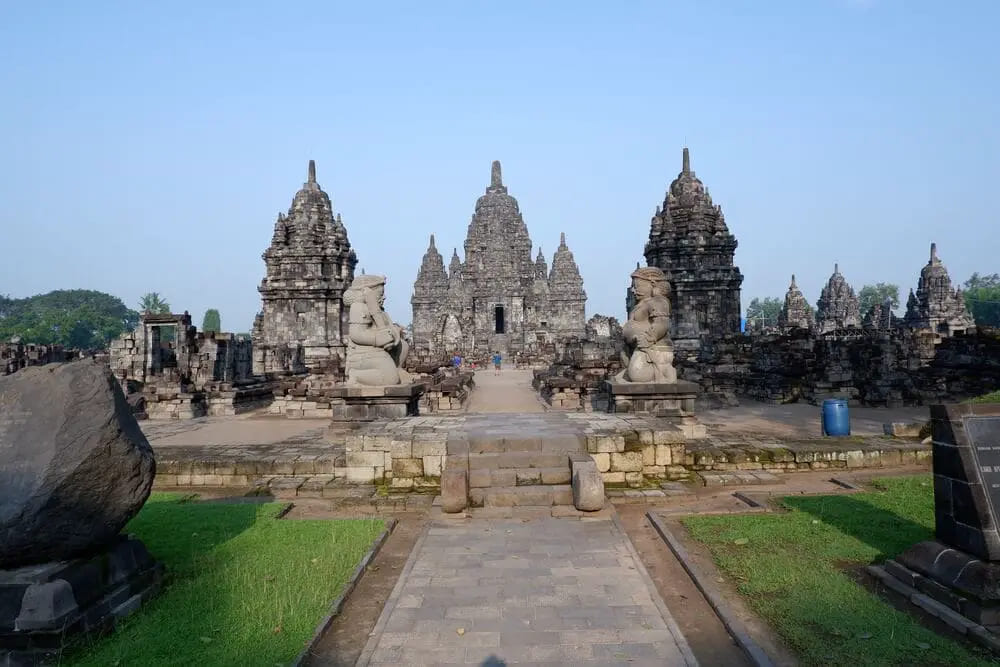
Java Backpacking Itinerary at a glance
The following examples itineraries on Java all assume you land in Jakarta and want to reach Bali overland.
Everything in this guide and the itineraries is perfectly reversible: You can start in Bali and finish in Jakarta (or Yogyakarta).
7 days
- Day 1: Jakarta;
- Day 2-3: Yogyakarta, Borobudur & Prambanan;
- Day 4: Malang;
- Day 5: Tumpak Sewu;
- Day 6: Bromo and Madakaripura;
- Day 7: Kawah Ijen;
- Ferry to Bali.
10 days
- Day 1: Jakarta;
- Day 2: Bandung;
- Day 3-4: Yogyakarta, Borobudur & Prambanan;
- Day 5: Surakarta;
- Day 6: Malang;
- Day 7: Tumpak Sewu;
- Day 8: Surabaya;
- Day 9: Bromo and Madakaripura;
- Day 10: Kawah Ijen;
- Ferry to Bali.
14 days
- Day 1: Jakarta;
- Day 2-3: Bandung, Tangkuban Perahu;
- Day 4-6: Yogyakarta, Borobudur & Prambanan, Goa Jomblang;
- Day 7: Dieng Plateau;
- Day 8: Semarang;
- Day 9: Surakarta;
- Day 10: Malang;
- Day 11: Tumpak Sewu;
- Day 12: Surabaya
- Day 13: Bromo and Madakaripura;
- Day 14: Kawah Ijen;
- Ferry to Bali.
All of the places of interest and attractions are added to this interactive map:
This guide follows the 14-day Java Backpacking Itinerary but offers jump links if you only have 1 week or 10 days.
You can also spend more days in some places and skip others. For example, you can skip Surabaya and stay around Mt. Bromo an extra day or skip Semarang to stay 1 more day in Yogyakarta or Dieng Plateau.
Day 1: Jakarta
Chances are, you’re either landing in Jakarta or flying out of it. The Big Durian is not just big, it’s humongous. Jakarta is projected to become the world’s biggest city by 2030.
Somehow it’s not what it’s most popular for. Come now, when I say Jakarta, you say traffic. Jakarta = traffic.
I once spent 4 hours on a bus from the airport to the city center (40 km). It’s horrible. Yes, other big cities in Java suffer from the same problem, but in Jakarta, it’s become ridiculous.
A running joke is that the best thing to do in Jakarta is to leave as fast as possible.

That’s why I give Jakarta only 1 day in my Java backpacking itinerary. If you have spare time, some of the notable places of interest are:
- The National Monument (Monas) and Merdeka Square;
- National Museum of Indonesia;
- Kota Tua (Old Batavia): The Old Town and a proposed UNESCO site;
- Menteng Flea Market;
- Istiqlal Mosque: Biggest in Indonesia and Southeast Asia, 6th biggest in the world;
- Taman Anggrek Mall: The biggest mall in Indonesia;
- Ancol Beach;
To continue the 7-day itinerary. Take an overnight train to Yogyakarta.
Luxury trains depart from Gambir Station.
Cheaper trains depart from Pasar Senen.
Learn more about the trains from Jakarta to Yogyakarta
To continue the 10 or 14 days itinerary.
Take a morning train to Bandung from Gambir Station.
Days 2-3: Bandung
Traveling from Jakarta to Bandung you will gain 700 meters altitude. Bandung is situated high and as a result the regional climate there is cooler.
Bandung is nicknamed the Paris of Java because of its beauty and fashion industry.
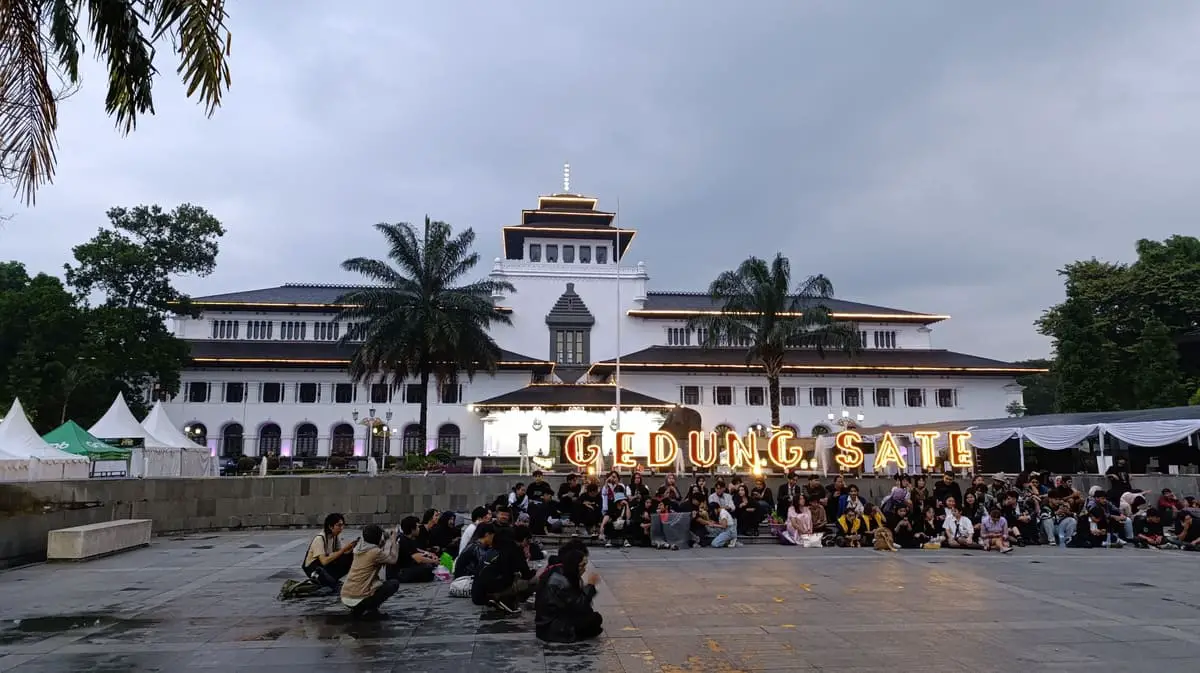
Surrounded by tea plantations and volcanic landscapes, the area around Bandung offers breathtaking vistas and outdoor adventures. In the city itself, you can find fashion boutiques, indie cafes, and hipster hangouts.
First day in Bandung
- Pasar Baru
- Taman Hutan Raya
- Lembang Floating Market
- Jalan Braga
- Gedung Sate (optional)

Taman Hutan Raya
Upon arrival from Jakarta, take a moment to have lunch somewhere around Pasar Baru (5 min from Bandung Station) or try some Indonesian fried snacks from a street vendor.
Drop off your backpack in your hostel (I recommend Tokyo Cubo) and take the Green or Orange Angkot (Angkots are the minibuses that serve as Bandung’s public transport. Their routes are on Google Maps) all the way to Taman Hutan Raya, a large conservation area park with a botanical garden.

Lembang Floating Market
I walked through the park to Lembang (about 10 km but very pleasant) to the Lembang Floating Market. Just make sure you arrive before 17:00 because the market closes at 18:00.
The Lembang Floating Market should be a charming experience where traditional market culture meets a unique twist. Unfortunately, I found it tacky and overly touristic. Everything was set up in a way that resembled an open-air amusement park. Around the floating market are a lot of activities that are more suited to the younger audience.
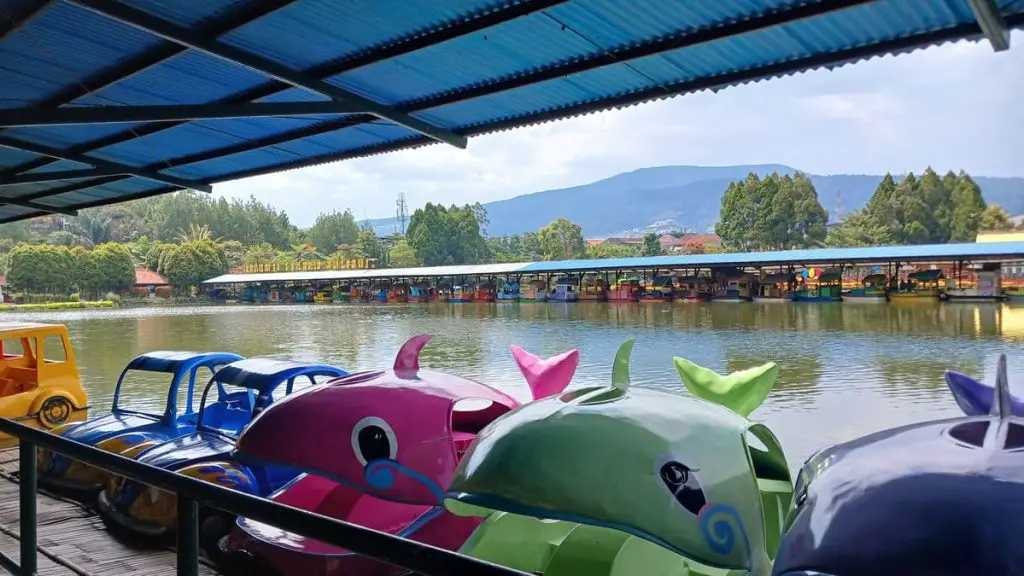
Moreover, every activity charges an entrance fee and the whole area also charges for an entrance ticket (35.000 IDR). Suffice it to say, it’s not the most authentic experience, but to each his own. I expected something like the Cai Rang Floating Market in South Vietnam but received a Luna Park.
To return to Bandung take the creamy gray Angkot from Terminal Lembang or a Grab taxi.
Jalan Braga
In Kota Bandung, you really should have a walk down Jalan Braga, a historic and vibrant avenue known for its colonial-era architecture, shops, cafes, and art spaces.
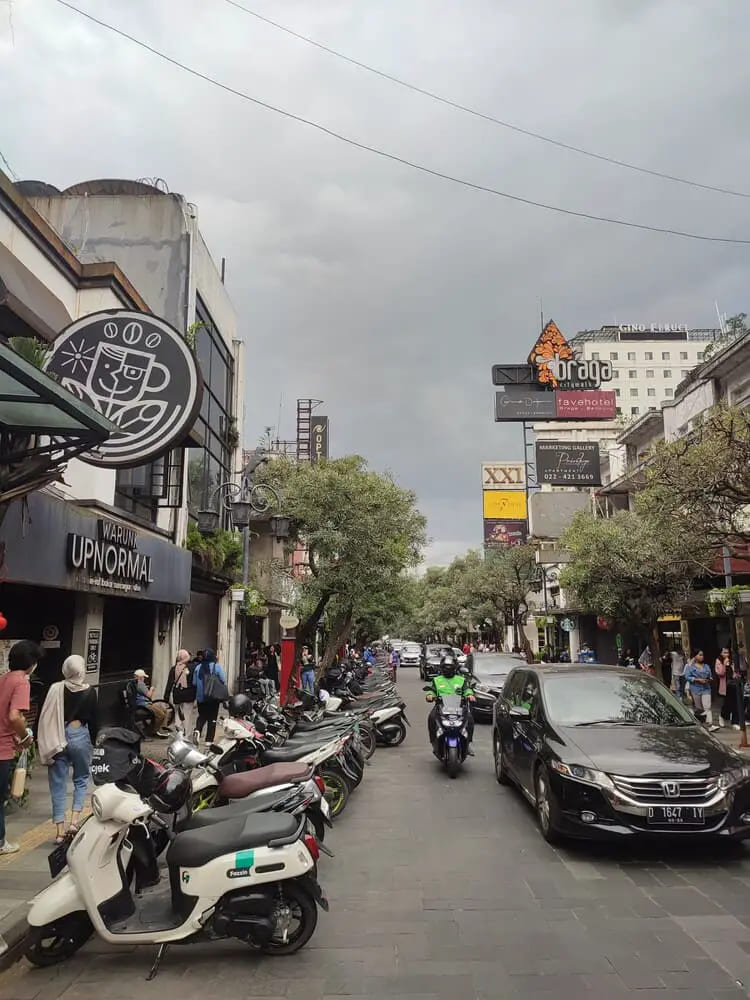
Gedung Sate
If you have extra time, take an hour to visit Gedung Sate – an iconic government building featuring Dutch colonial architecture and a museum showcasing local history.
To continue the 10-day itinerary.
At the end of your second day in Bandung, take an overnight train to Yogyakarta.
There are many trains every day (and late evening) departing from both Bandung and Kiaracondong stations bound for both Yogyakarta Tugu and Lempuyangan stations of Jogja.
Second Day in Bandung
There are many options for activities in and around Bandung on day 2, but the most impressive one is the active volcano Tangkuban Perahu. If you missed Lembang Floating Market, you can stop by as it’s on the way.
Tangkuban Perahu
Tangkuban Perahu is a stratovolcano known for its unique upside-down, boat-shaped crater. You can explore its smoking vents and enjoy panoramic vistas
Hot springs and lush greenery add to the enchantment of this natural wonder.
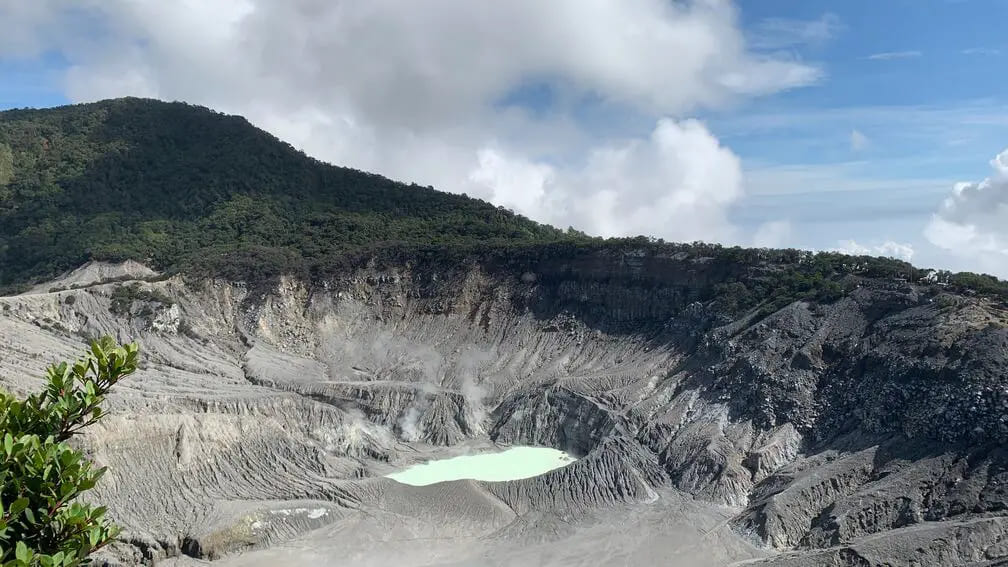
To reach it by public transport, take the same creamy gray Angkot from yesterday towards Lembang. Then take another one towards Cikole. Get off at the entrance to Tangkuban Perahu and continue on foot.
The volcano is only 30 km from Bandung, so if you want a faster and more convenient transport option, just get a Grab taxi.
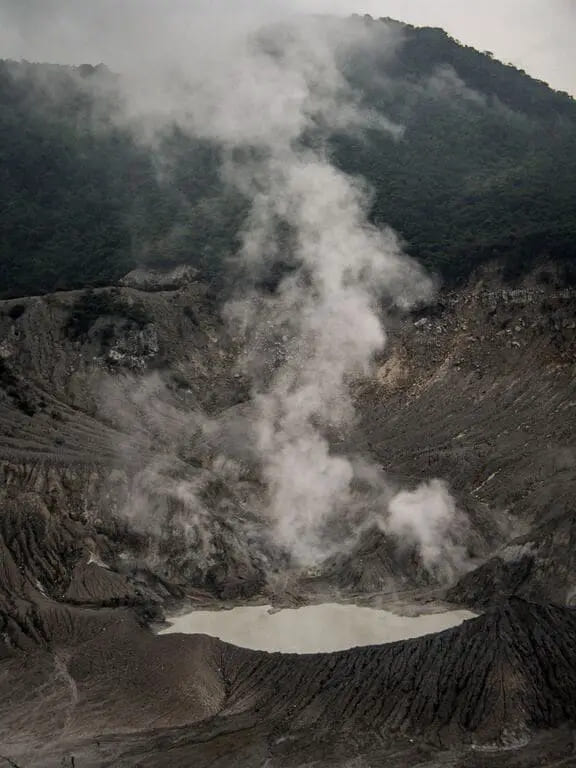
The entrance fee to Tangkuban Perahu is 200.000 IDR / 13$ (weekday) or 300.000 / 20$ (weekend) for foreigners. It’s expensive and you will see a trend in Indonesia how attractions cost 10 times what the locals pay. It is what it is.
Shopping in Bandung
Bandung is famous for its affordable shopping and developed fashion industry. It presents itself as a cheaper alternative to shopping in Singapore or Kuala Lumpur for international tourists.
Some of the shopping streets you can check out in the afternoon after you return from Tangkuban Perahu are:
- Jalan Riau (Riau Street): Known as the “Fashion Street” of Bandung, Jalan Riau is lined with numerous factory outlets and boutiques offering a wide range of clothing, shoes, and accessories;
- Jalan Dago (Dago Street): This street is home to a mix of shopping options, including factory outlets, cafes, and local shops;
- Jalan Setiabudi (Setiabudi Street): Another hub for factory outlets and shopping centers, Jalan Setiabudi offers a variety of fashion and sportswear brands;
- Jalan Cihampelas (Cihampelas Street): Also known as “Jeans Street,” Jalan Cihampelas is famous for its denim-focused shops, as well as modern shopping malls and unique street markets.

Other things to do in Bandung (if you have more time)
- Kawah Putih: A stunning white crater lake located south of Bandung with a surreal landscape;
- Saung Angklung Udjo: Experience traditional Sundanese culture through music and performances involving the angklung bamboo instrument;
- Explore Trans Studio Bandung: One of the largest indoor theme parks in the world, offering a variety of exciting rides and entertainment;
- Ciwidey Valley: Enjoy picturesque landscapes, strawberry picking, and the thrill of off-road adventures;
- Bandung Geology Museum: Learn about the Earth’s geological history and the natural wonders of Indonesia through various exhibits;
- Bosscha Observatory: The oldest observatory in Indonesia, allowing you to observe celestial wonders through powerful telescopes;
- Rabbit Town: A quirky spot with various rabbit-themed attractions, ideal for families and animal lovers;
- Maribaya Waterfall: Enjoy the natural beauty of cascading waterfalls surrounded by lush greenery and cool mountain air.
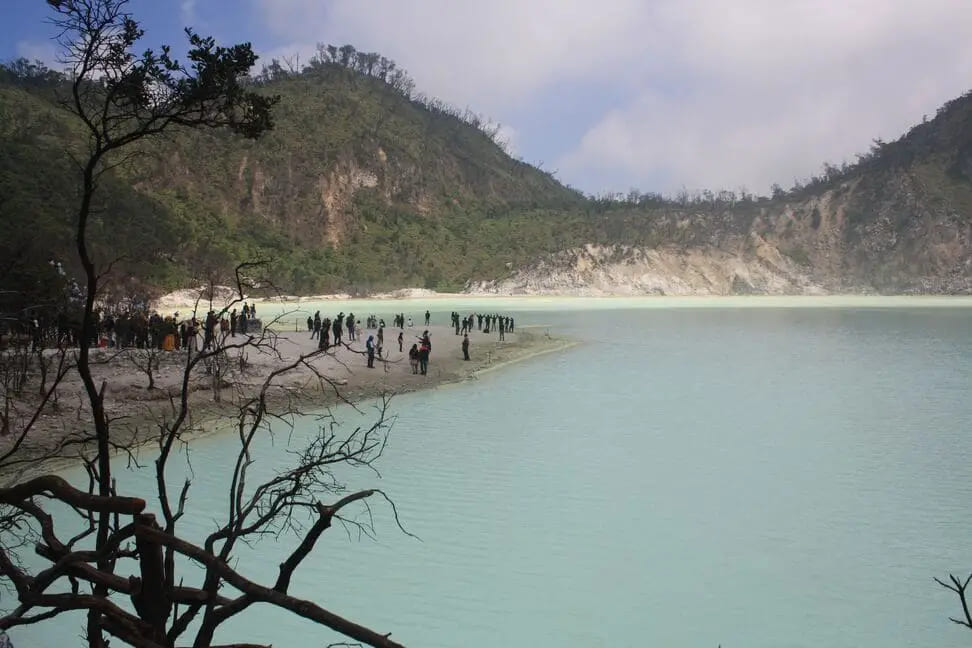
At the end of your stay in Bandung, take an overnight train to Yogyakarta, the cultural capital of Java.
There are many trains every day departing from both Bandung and Kiaracondong stations bound for both Yogyakarta Tugu and Lempuyangan stations of Jogja.
Day 4-6: Yogyakarta
Yogyakarta, or Jogja, is the real deal when it comes to Javanese culture, ancient architecture, wonderful cuisine, and authentic experiences. It is a definite stop in any Java itinerary.
Daerah Istimewa Yogyakarta is one of only two special regions in Indonesia (the other one being the ultra-conservative Muslim Aceh) and the only place in the archipelago still ruled by a monarch – in this case the Sri Sultan Hamengkubuwono X.
In September 2023, Yogyakarta became Indonesia’s newest UNESCO heritage site!
The cosmological axis of Yogyakarta, an imaginary line running from Mount Merapi, through the Sultan’s Palace, all the way to the South Seas, was awarded the recognition at a meeting of UNESCO in Saudi Arabia.
You can walk the axis starting at Tugu Monument, down by Malioboro, the north alun-alun, through the Kraton, the south alun-alun, leave the walled city, and walk all the way to the south gate Panggung Krapyak.
Then on a day trip, you can visit Parangtritis Beach where the axis ends and in the evening go on a Lava Tour to the Merapi Volcano at the axis beginning.
I called Yogyakarta home on and off for 6 months in 2023 and it’s my favorite city in Java!
First day in Yogyakarta
- Prawirotaman
- The Kraton (Sultan’s Palace)
- Taman Sari (Water Castle)
- Malioboro
- Alun-alun Kidul

Read my recommendations about authentic things to do in Yogyakarta, including detailed information about the places in this guide.
Prawirotaman
Assuming you’re arriving in the morning with the overnight train from Bandung, you’re probably a bit tired. Take it easy!
Drop off your bags in one of the cool garden-style hostels or guesthouses around Prawirotaman (the so-called “bule (foreigner) area“).
I recommend Arjuna Garden Homestay.
Take a walk around Prawirotaman and enjoy the cool street art. Go into the smaller streets to appreciate the quaint character of Jogja.

Kraton Yogyakarta
Kraton Yogyakarta, the royal palace of the Sultan, embodies Javanese culture and history. Ornate architecture, courtyards, and cultural artifacts depict its significance as a living heritage site.
It preserves traditions through performances and ceremonies you can witness daily.
Even though the Sultan lives there, chances are you won’t get to see him. Even locals who live right next to the Kraton tell me that they’ve never seen him in person! Odd, isn’t it?
Taman Sari
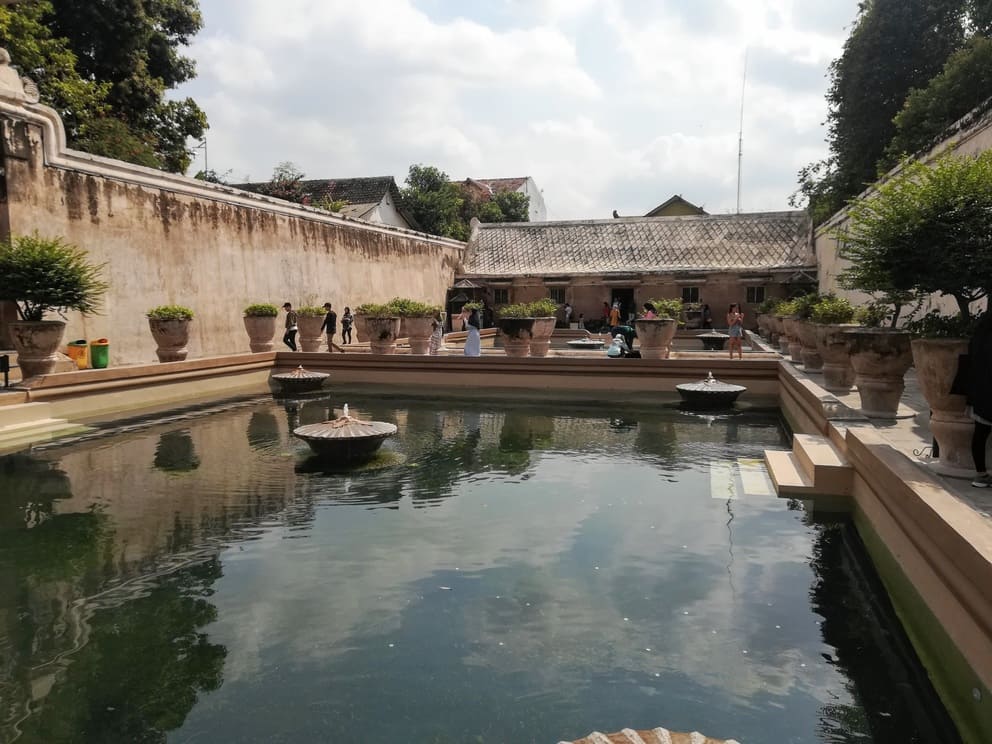
Taman Sari, Yogyakarta’s water palace, melds beauty and history. Built in the 18th century, it boasts pools, gardens, and unique architecture. Serving as a retreat for the Sultan, it holds stories of leisure and romance.
Taman Sari is walking distance away from the Kraton (well, it was where the first Sultans kept their concubines after all) so it’s logical to combine them.
Malioboro
In the evening go to Yogyakarta’s main artery – Jalan Maliboro.
Malioboro is lined with shops, stalls, and street vendors. It is an iconic destination in Yogyakarta for its lively spirit and diverse offerings.
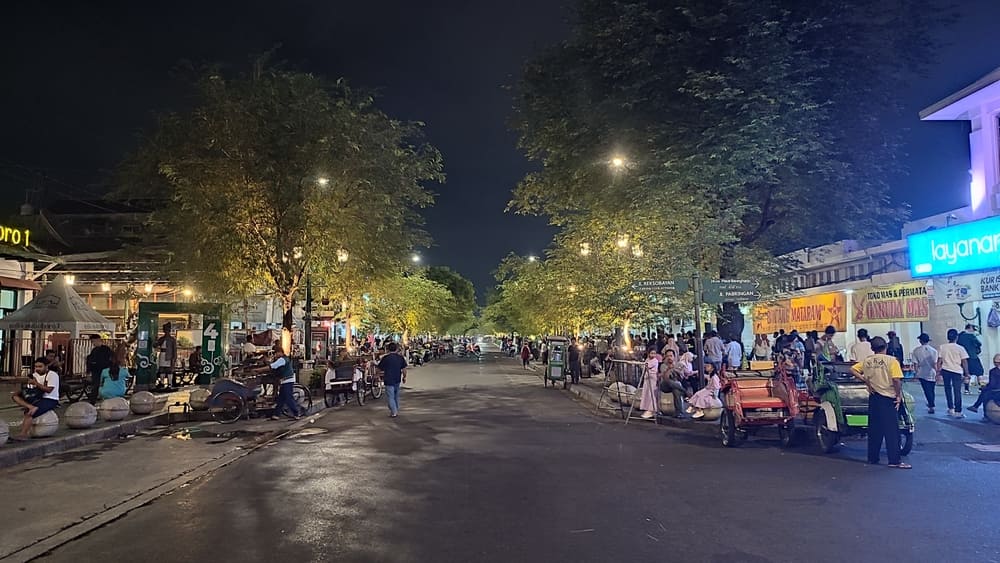
Malioboro comes alive every evening with musicians, dancers, and street performers entertaining tourists and locals alike.
Alun-alun Kidul
On your way back to Prawirotaman, stop at the south public square, also known as Alun-alun with “kidul” meaning south. Just call it “Alkid” if you want to be cool.
You can’t miss it – look for the two giant Masagin trees in the middle of an empty slot of 110m. x 110m. land, surrounded by street food stalls and neon pedaled cars called odong-odong.
Close your every facing the middle of the trees, rotate in one place 4-5 times, then try to walk in the middle of the trees in what’s called the Masagin Challenge. Shall you succeed, great things await you.

Don’t forget to try some of the amazing Indonesian street food snacks on the over 100 stalls around the alun-alun.
After dinner, look for some of these Indonesian desserts to cater to your sweet tooth!
Second day in Yogyakarta
- Borobudur Temple
- Prambanan Temple
- Chicken Church (Gereja Ayam)
- Smaller ancient temples
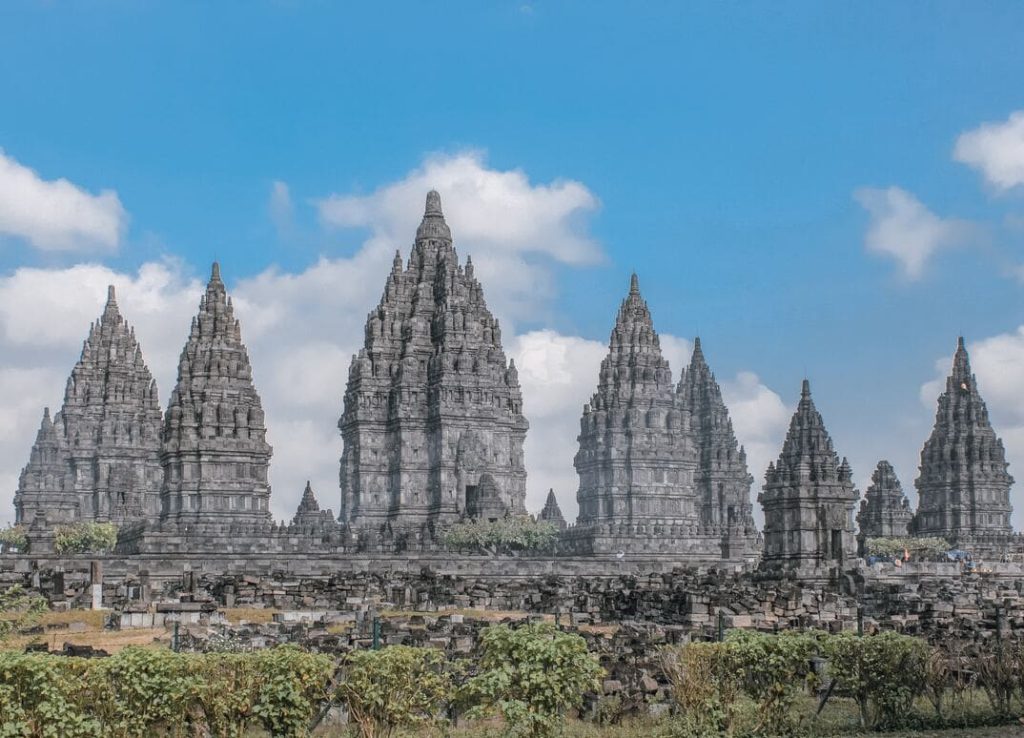
Your second day in Yogyakarta is what I call the Ancient Heritage Experience. Today you visit the 2 UNESCO heritage sites around Yogyakarta that make it such a popular destination – Borobudur and Prambanan.
I have this in-depth guide on how to visit Borobudur and Prambanan in 1 day, including how to reach Borobudur by direct bus from Terminal Jombor.
Alternatively, check out this one about sunrise at Borobudur and this one about sunset at Prambanan.
You should also read about the amazing Ramayana Ballet with shows every Tuesday, Thursday, and Saturday.
Borobudur Buddhist Temple
You can find up-to-date information about how to reach Borobudur and watch the sunrise in the linked article.
Borobudur, Indonesia’s ancient marvel, stands as a colossal Buddhist temple (the biggest in the world actually). Constructed in the 9th century, it showcases intricate carvings and tiered stupas, symbolizing spiritual enlightenment.
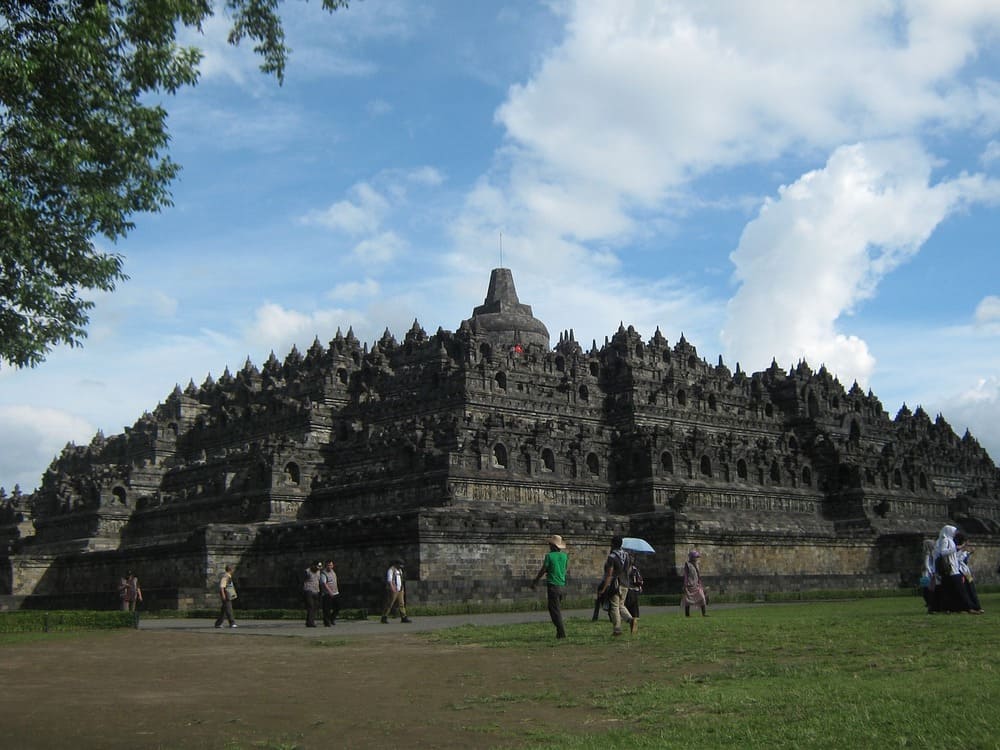
Chicken Church (Gereja Ayam)
Very near Borobudur is this bizarre temple in the shape of a chicken. Well, no, actually it’s a dove, except for the fact it doesn’t look like a dove at all! But oh my, oh my, what a funky story there is behind this oddity.
Prambanan Hindu Temple
Prambanan, an architectural masterpiece in Indonesia, showcases intricate Hindu craftsmanship.
Also dating back to the 9th century (exemplifying the religious syncretism of the Majapahit Empire), it’s a complex of towering temples adorned with intricate carvings depicting epic narratives.
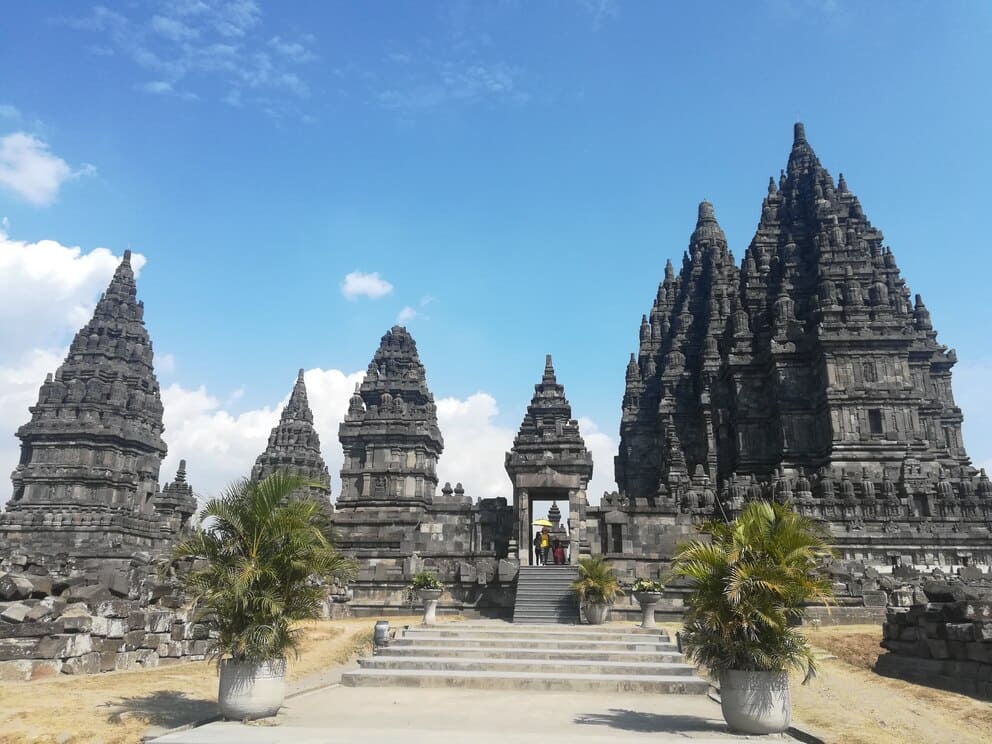
You can reach Prambanan by bus 1A/K3J from Malioboro. Here you can find detailed information about how to get from Yogyakarta to Prambanan.
Other Ancient Temples to visit around Yogyakarta
Since Prambanan and Borobudur are so famous, many think they are the only ones. On the contrary – there are over 20 smaller Buddhist and Hindu temples spread around Yogyakarta.
Some of the best ones are:
- Mendut (close to Borobudur);
- Pawon (close to Borobudur);
- Sewu (close to Prambanan);
- Plaosan (close to Prambanan).
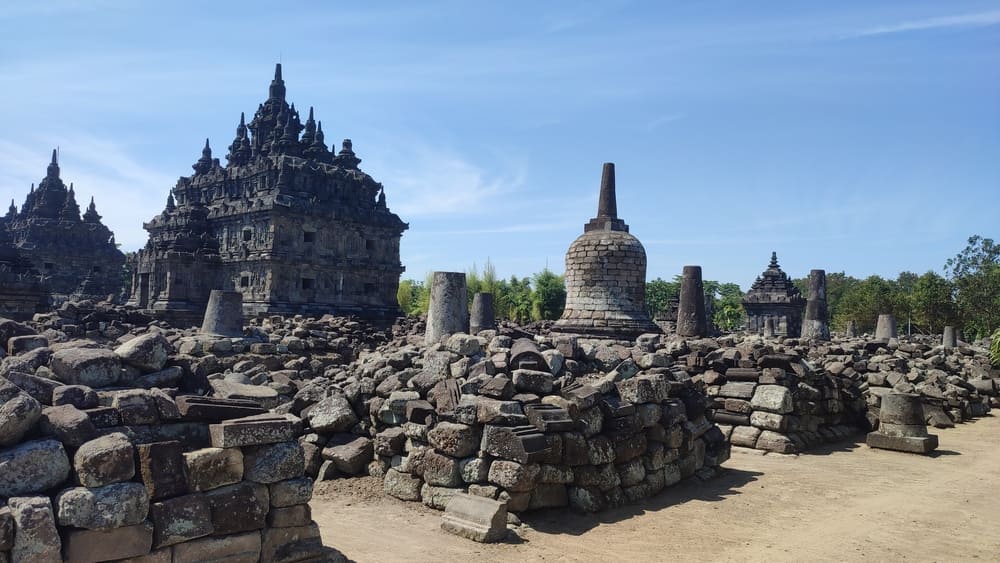
To continue the 7-day itinerary.
Take an overnight train to Malang.
Trains depart from Yogyakarta Tugu Station.
To continue the 10-day itinerary.
Take a train to Surakarta.
Commuter trains depart from Yogyakarta Tugu Station about every hour.
Check this out if you want to travel from Yogyakarta directly to Bali.
Third day in Yogyakarta
On your third day in Yogyakarta, it’s time for some adventures!
While there are many cool places to visit around Jogja, I don’t think anyone can argue with me if I say that Goa Jomblang Cave should be at the top of the list.
Goa Jomblang
Goa Jomblang, a natural wonder about 50 km southeast of Kota Yogyakarta, offers an otherworldly experience. It’s a vertical cave with a “heaven’s light” phenomenon. You rappel down the cave to witness its ethereal beauty.
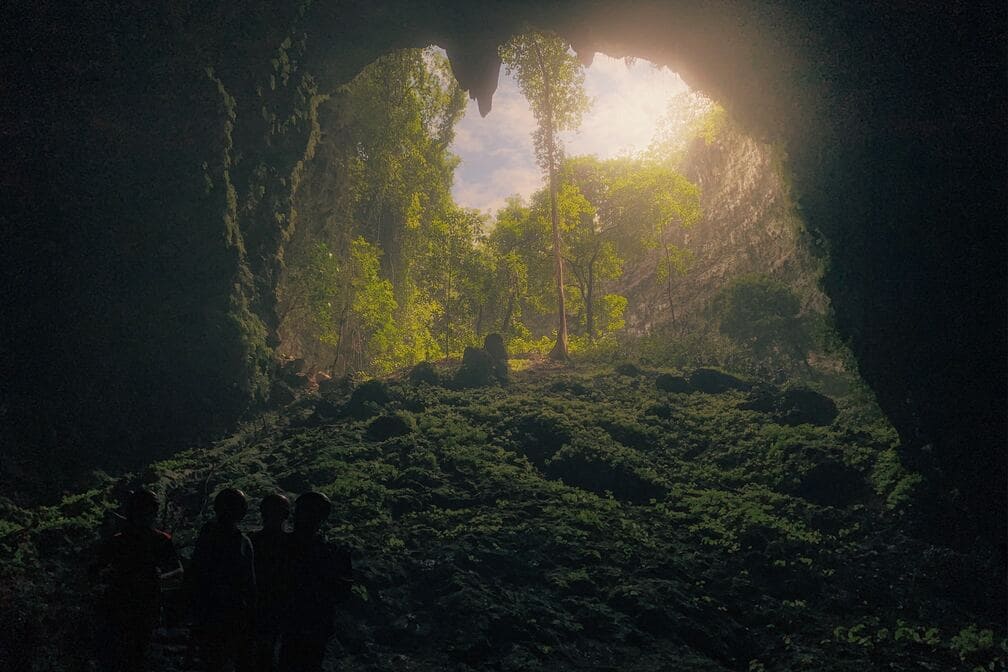
While getting to Goa Jomblang independently is not impossible (just take a bus from Terminal Giwangan towards Wonosari, then take a Grab taxi to the cave), organizing a tour of it could be tricky without booking beforehand.
I recommend this day tour from Yogyakarta which combines Goa Jomblang with Timang Beach.
Kampung Hunting back in Jogja
One thing I love about Jogja and is rarely talked about is the kampungs.
Kampungs are Indonesian neighborhoods, characterized by small winding alleys, beautifully decorated walls, and tightly-knit communities, and are the place to visit to see how the locals really live.
You can see my favorite Kampungs in Jogja in my list of things to do in Yogyakarta.

Other things to do in Yogyakarta (if you have more time)
- Hike up to Merapi Volcano or do a Merapi Lava Safari tour with a jeep;
- Watch traditional Javanese performances like the Prambanan Ramayana Ballet
- Shop for Batik, a traditional Indonesian textile;
- Visit Fort Vredeburg Museum and learn about the Indonesian struggle for independence;
- Visit Sonobudoyo Museum to learn more about culture and art in Java;
- Visit the Ullen Sentalu Museum (in Kaliurang, the village closest to Merapi);
- Explore the Affandi Museum for contemporary art;
- Take a cycling tour around rural villages;
- Explore the underground river at Goa Pindul;
- Visit the occult Royal Cemetery at Imogiri or the even older Royal Cemetery at Kota Gede;
- Go to the beaches in the south. The most famous beach is Pantai Parangtritis.
- Check out my article about experiences in Yogyakarta for more.
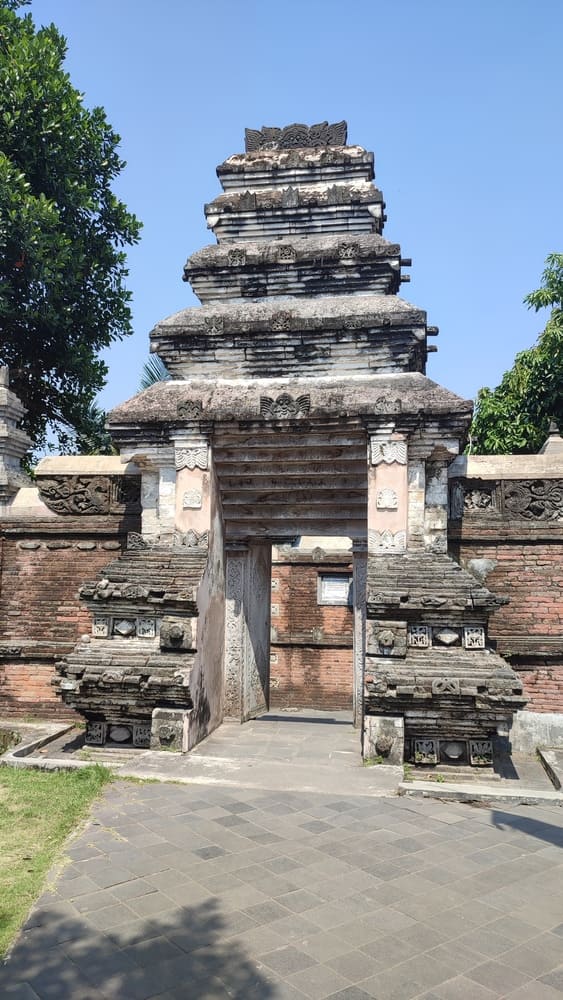
Day 7: Dieng Plateau
I have an in-depth guide about Dieng Plateau, including how to get there from Yogyakarta, where to sleep, and what to see and eat on a 1-day trip there.
Dieng is a volcanic plateau with a multi-colored lake, ancient Hindu temples (the oldest on Java!), and a pretty cool sunrise (when there aren’t too many tourists and it isn’t too misty).

It’s often overlooked by those backpacking in Java but is totally worth it. My 7 and 10 days itineraries don’t include it only because of the lack of time coupled with Dieng’s remote location. Dieng Plateau is exciting and awesome!
The top things to see and do at Dieng Plateau are:
- Sikunir Hill: Watch the sunrise over the whole plateau and Mount Sundoro with the clouds under your feet;
- Sikidang Crater: Witness the geothermal activity at this bubbling mud crater, surrounded by hissing steam vents and vibrant mineral deposits;
- Arjuna Temple Complex: Explore a collection of ancient Hindu temples with intricate carvings, showcasing Dieng’s historical and cultural significance;
- Colorful Lakes: Marvel at the vivid hues of Telaga Warna and Telaga Pengilon, two stunning lakes colored by mineral deposits that change with the light;
- Eat Carica: the local jelly-like dessert made with baby papayas.

Day 8: Semarang
To reach Semarang from Dieng Plateau, take a local minibus to Wonosobo, then transfer to an intercity bus at Terminal Mendolo going directly to Semarang.
Its Dutch colonial past is reflected in the architecture of the Old Town area (Kota Lama), while vibrant markets and local cuisine showcase its cultural richness.
The iconic blend of youthful energy and historical charm is evident in attractions like Lawang Sewu, a grand colonial-era building, and the Sam Poo Kong temple complex.
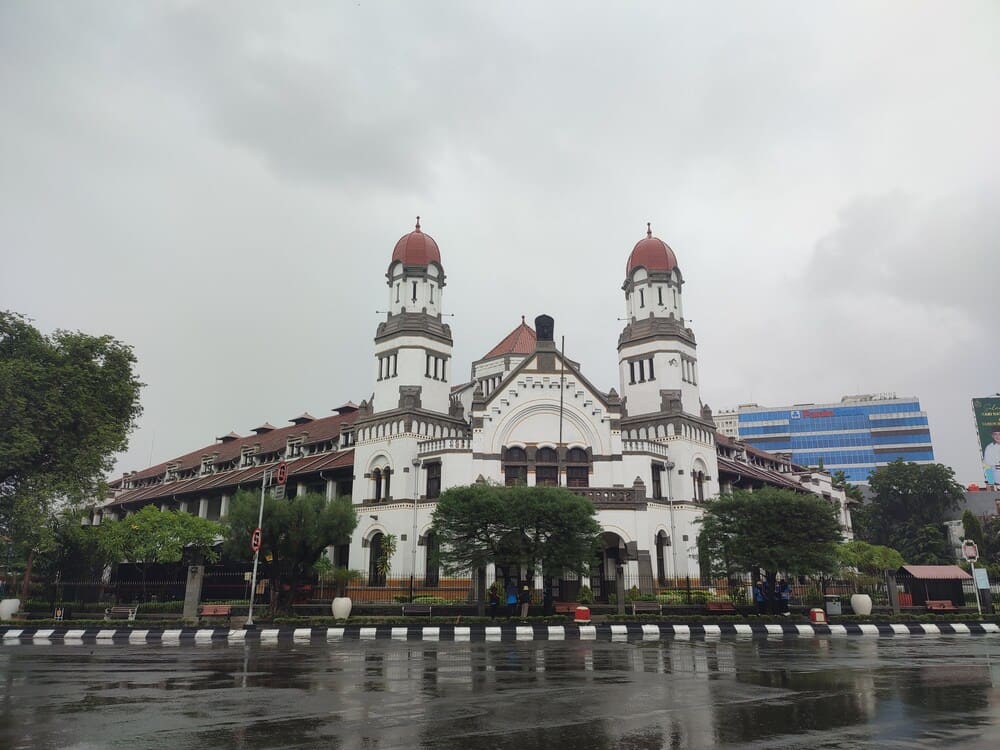
Venture a little further and you will be rewarded with the highest pagoda in Java – Avalokitesvara.
Check out my extensive list of things to do in Semarang.
Some of the best things to do in Semarang are:
- Lawang Sewu: Explore this iconic Dutch colonial building, known for its fascinating history and impressive architecture;
- Sam Poo Kong Temple: Visit the oldest Chinese temple in Semarang, reflecting the city’s cultural diversity;
- Old Town (Kota Lama): Wander through the charming streets of the Old Town, filled with colonial-era buildings, museums, and cafes;
- Semarang Night Market (Warung Semawis): Experience the vibrant atmosphere of this bustling night market, offering street food, crafts, and entertainment;
- Great Mosque of Central Java: Visit this grand mosque, admired for its stunning architecture and serene ambiance. It’s the biggest mosque in Central Java!;
- Tay Kak Sie Temple: Explore this colorful Chinese temple, known for its intricate decorations and peaceful surroundings;
- Yayasan Buddhagaya: A temple complex with the elegant, 7-tiered pagoda Avalokitesvara, a dozen Buddhist temples in a green, statue-filled garden.
- Marina Beach: Relax at this urban beach, offering beautiful views, seafood stalls, and a leisurely escape by the sea.
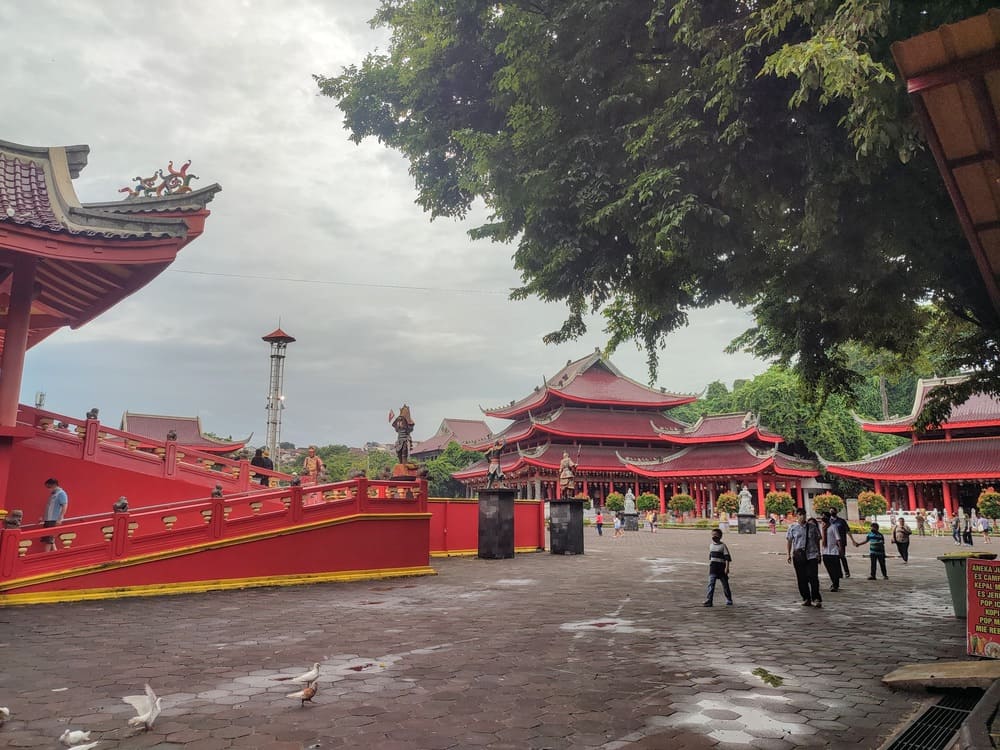
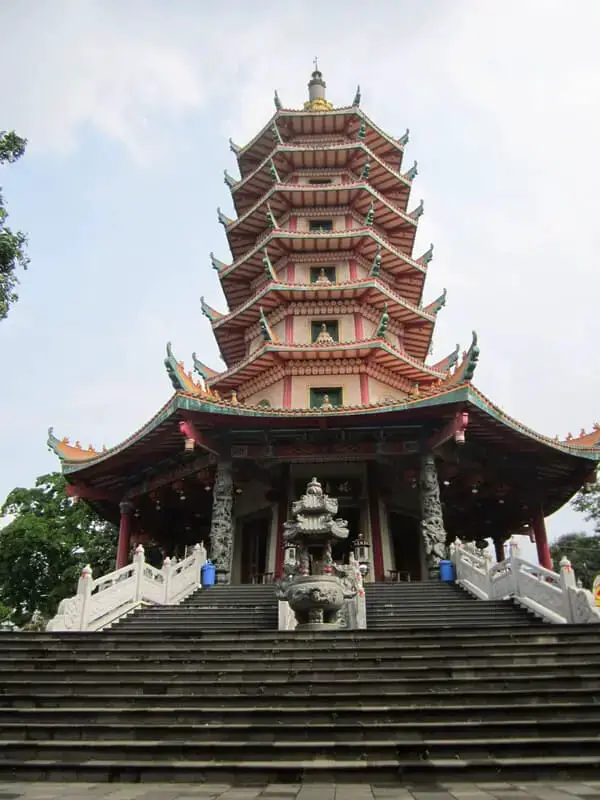
Day 9: Surakarta
Reach Surakarta from Semarang by a 2-hour early morning train from Semarang Tawang Station. It’s also connected to Yogyakarta with hourly commuter trains.
Surakarta is Yogyakarta’s smaller sister. It used to be a Sunanate (something like a Sultanate, but using a different word) with a special status which it lost because it wasn’t careful with its communists (I’m not joking, look it up).
Surakarta, commonly referred to as Solo, is a fun city anyhow. It stands out for its profound Javanese heritage, offering a tapestry of traditional batik craftsmanship, captivating classical court arts, and enchanting Gamelan melodies.
At the heart of Solo lies the impressive Kraton palace, a testament to its regal history. The city’s dynamic markets bustle with life, showcasing an array of local products from batik to pottery.
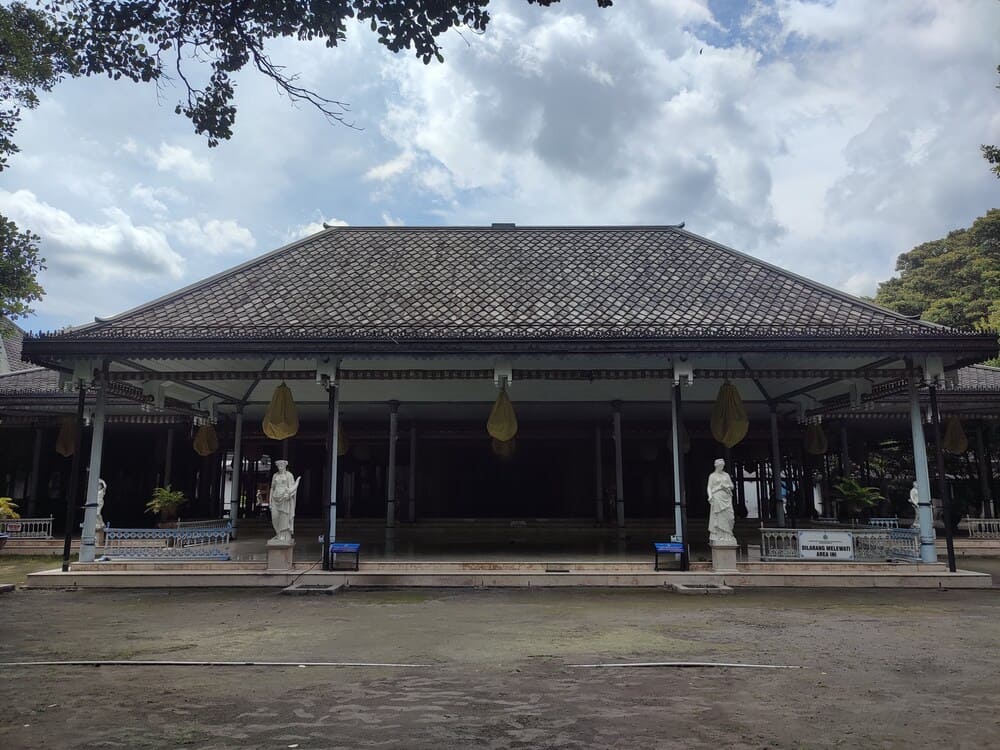
One exciting thing about Surakarta is that it’s where remnants of the first humans on Java were found. What is now called Solo Man is evidence of the prehistoric life on Java. It is also a UNESCO heritage site.
You should really check out my list of top things to do in Surakarta and pick the ones you most like. Here’s my selection:
- Kraton Surakarta: Explore the royal palace, Kraton Surakarta, to discover Javanese architecture, history, and culture;
- Museum Sangiran and the Sangiran Early Man Site: A UNESCO heritage site evidence of the first people on Java. It’s a wonderful museum and a fascinating deep-dive into pre-historic times;
- Wayang Orang Theatre: Witness the mesmerizing moves of the Javanese theater for under 1$ by going to Sriwedari Wayang Orang Dance Theatre and experiencing this intrinsic part of Javanese culture;
- Pasar Klewer Market: Immerse yourself in the vibrant atmosphere of Pasar Klewer, a bustling market famous for its batik textiles;
- Laweyan Batik Village: Wander through Laweyan, an old batik village where you can witness the traditional production of batik textiles;
- Ngarsopuro Night Market: Go to Solo on the weekend to try some of the local food at the night market. I recommend the serabi pancakes!
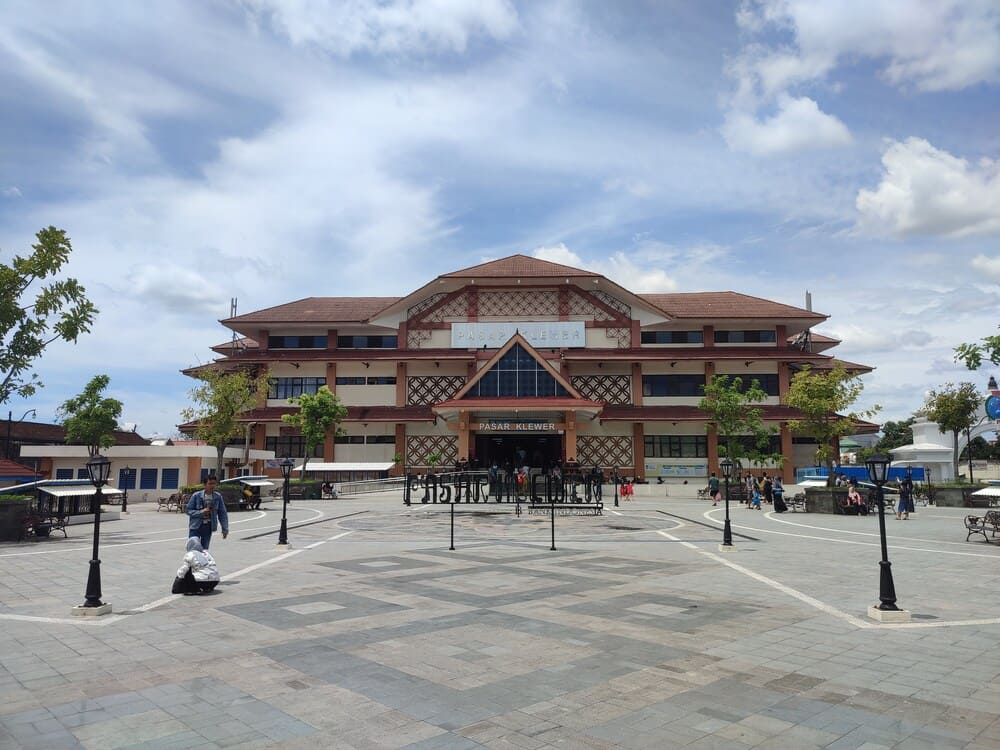
At the end of your stay in Surakarta (Solo for train booking purposes), take a train towards Malang. Trains depart from both Balapan and Jebres stations in Surakarta, bound for both Malang and Malang Kota Lama stations.
Day 10: Malang
Malang is somewhat cooler than the hot Javanese lowlands. It is nicknamed Kota Dingin (Cold City).
Probably the most famous place in Malang is surprisingly the colorful kampungs in the center of the city, namely Warna Warni, KWJ, and Tridi, as well as the azure blue kampung Biru Arema on the other side of the bridge.
I love getting lost in a kampung and this thing about Malang really does it for me!
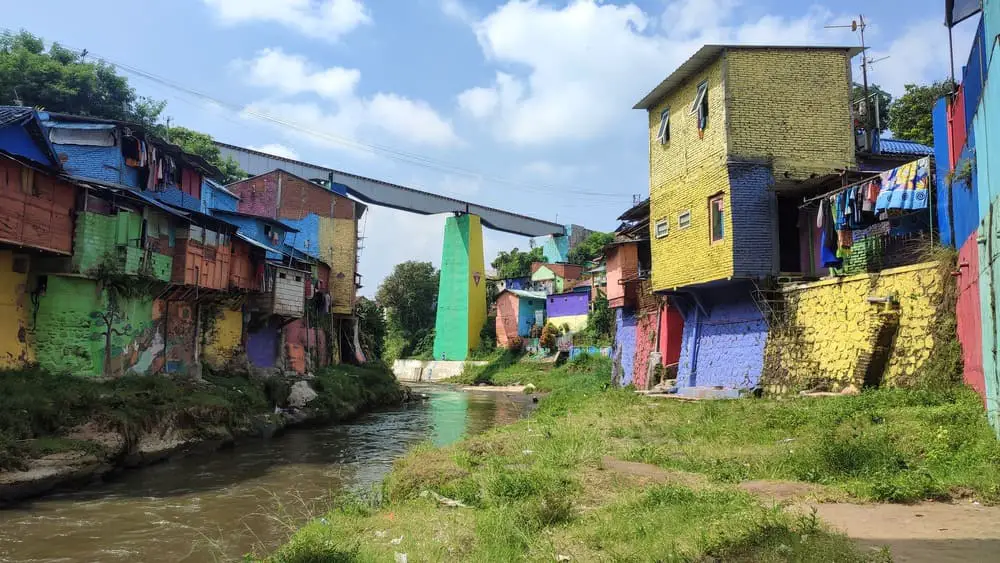

If you’re a fan of urban things to do, then just walking around the city will leave you content.
Watch out for Alun-alun Malang and the Malang Jami Grand Mosque, the Flower and Bird markets (Pasar Bunga and Pasar Burung) as well as the Brawijaya Museum, for some history into the Independence struggle.
If you like ancient temples and nature more, pay a visit to the 13th-century Hindu temple Singosari on the outskirts of town and the Coban Rondo Waterfall, only about 30 km from Malang.
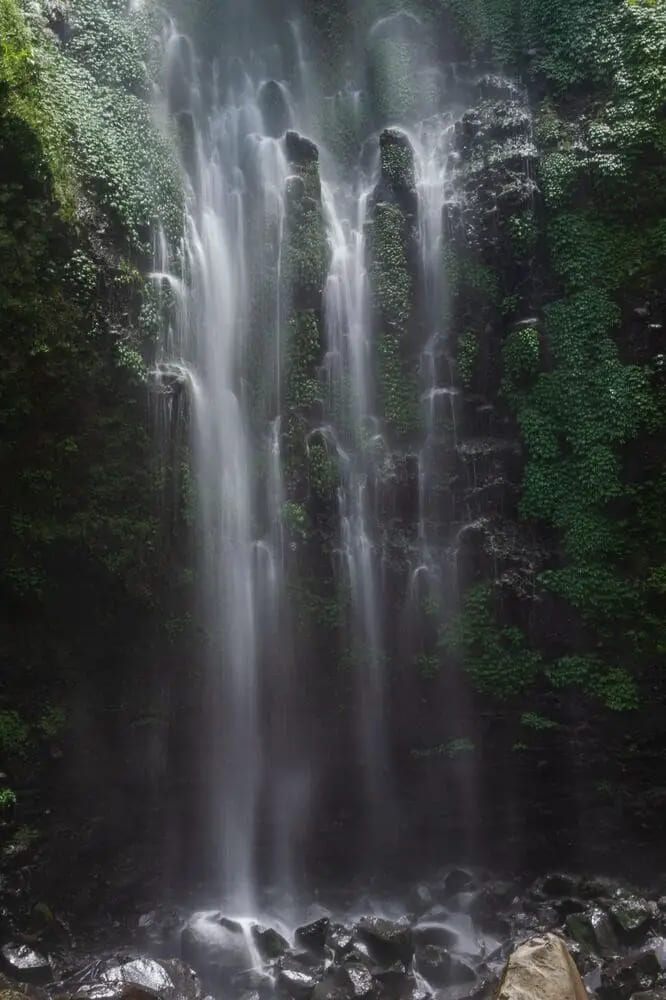
Some of the other notable things to do in Malang include:
- Explore Batu Night Spectacular: An amusement park offering a variety of rides, games, and a vibrant night market.
- Discover Jatim Park: A family-friendly attraction featuring a zoo, a dinosaur museum, and various educational exhibits.
- Experience Coban Talun: Another scenic waterfall with opportunities for trekking and adventure activities.
- Sample local cuisine: Try traditional dishes like rawon, rujak cingur, and bakso Malang at local eateries.
- Experience the Apple Plantations: Visit apple orchards in the Batu area, where you can pick your own apples and enjoy fresh produce. This is a good one.
- Learn about Transport at Museum Angkut: Explore a collection of vintage vehicles and gain insights into Indonesia’s transportation history.
- Discover Malang’s Coffee Culture: Enjoy a cup of locally produced coffee in one of the city’s cozy cafes while immersing yourself in its laid-back atmosphere. I recommend Treum Coffee.
- Explore Kidal Temple: Yet another Hindu Temple, but just as exciting as the others!;
- Shop at Pasar Apung: A floating market where you can buy fresh produce and local products from traditional boats.
- Explore the Sumberawan Temple: You can combine this one with Singosari as they’re close. Sumerawan is a Buddhist temple though;
- Experience the Tretes Highlands: Escape the city heat and enjoy cooler temperatures, lush landscapes, and panoramic views in this hill resort area. It’s a bit out of town, so only go if you have extra time.
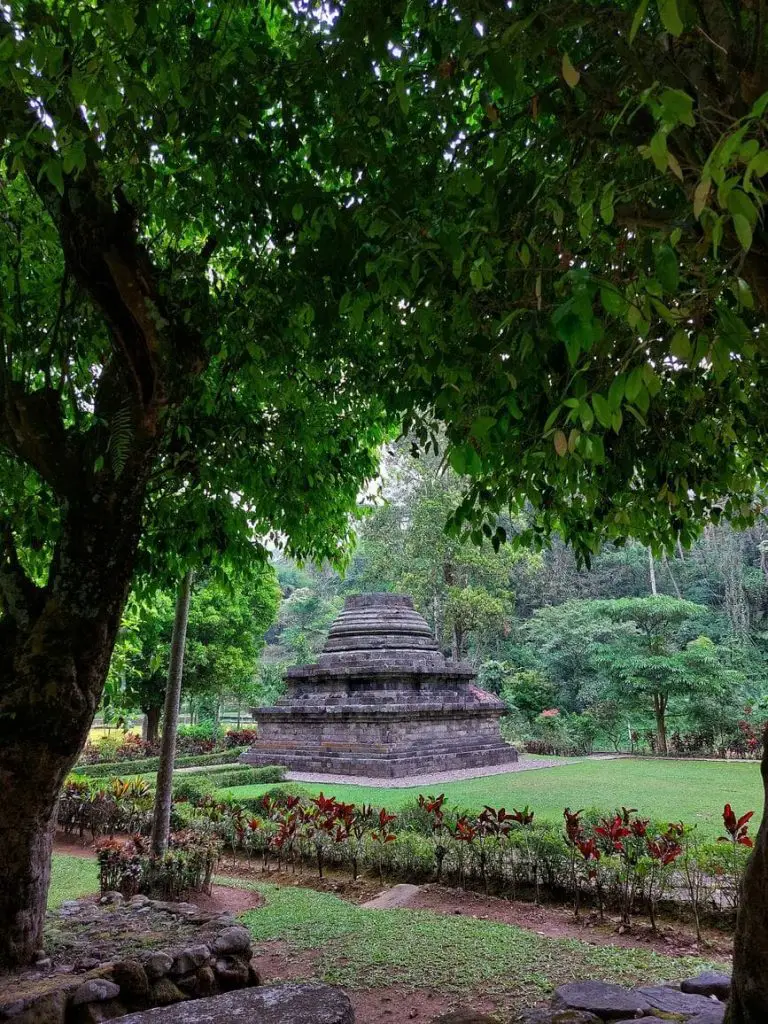
Day 11: Tumpak Sewu Waterfall
Visiting Tumpak Sewu is most convenient from Malang, the closest city to it. Your options to travel from Malang to Tumpak Sewu Waterfall are:
- Organized tour: It’s what most people do and is the easiest, but costly. I recommend this combination tour of Bromo Sunrise with Tumpak Sewu.
- Personal guide: Also expensive, but convenient. A motorcycle driver will set you back 400.000 IDR / 26$ two-way, whereas a car will be up to 700.000 IDR / 46$;
- Rent a motorcycle: That would be my choice. A motorcycle for a day costs ~100.000 IDR / 6.6$, fuel is super cheap (10.000 IDR per liter, 1 liter lasts about 40 km) and it gives you total freedom. Travel time between Malang and Tumpak Sewu is 2 hours;
- Public Transport: This option is a bit tricky as buses are infrequent and only depart once full. Take the bus from Terminal Bayangan Gadang and get off within walking distance of Tumpak Sewu. Note that getting back to Malang by public bus might not be possible!
Tumpak Sewu Waterfall

Tumpak Sewu is best done as a day trip from Malang.
Tumpak Sewu, meaning “Thousand Waterfalls” in Javanese is an enchanting natural wonder. With its awe-inspiring tiered structure, it resembles a curtain of water flowing gracefully down lush, towering cliffs and is often compared to Niagara Falls.
Don’t skip it when backpacking in Java!
To reach the waterfall you have to do a short but thrilling trek through verdant landscapes, crossing rivers and forests.
After a 20-minute walk from the entrance, you reach the viewpoint to see all of Tumpak Sewu from above. The view from this observation deck is truly a remarkable sight!

From the top, follow the trail down to the base of the waterfall. You will feel a bit like Tarzan with all the ropes and bamboo ladders in the midst of the jungle.
DO NOT WEAR FLIP-FLOPS THAT DAY!
The trek down isn’t dangerous, but you must be careful. If you’re not physically fit, it might be a good idea to enjoy Tumpak Sewu from above.
Otherwise, take your time trekking down, and beware of the slippery stones!
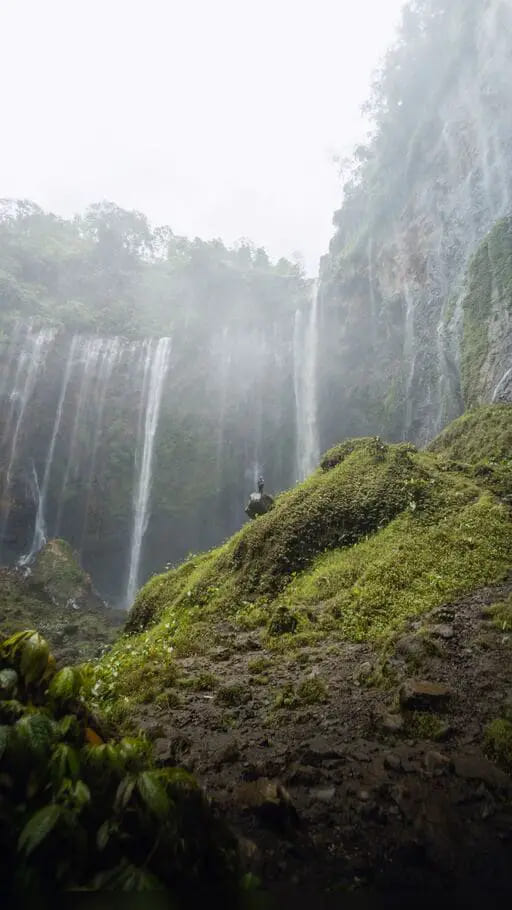
The entrance fee is 20.000 IDR / 1.3$.
Goa Tetes cave and waterfall
In the same locale as Tumpak Sewu there are many other smaller waterfalls and caves. The most picturesque and well-known is Goa Tetes.
Goa Tetes is a captivating underground cave system. Its unique allure lies in the mesmerizing stalactite and stalagmite formations, illuminated by soft lighting.
As for Goa Tetes Waterfall: you can’t miss it as it’s right next to Tumpak Sewu.
The entrance fee is 10.000 IDR / 0.7$.
Back to Malang or stay in Pronojiwo
If you’re on an organized tour, you won’t really have to worry about this part of the journey.
You basically have two options: go back to Malang or don’t. If you’re renting a motorcycle, you should go back to return it. If you’re with a private driver, he will take you back to Malang, but if you’re using public transport, it might be wise to sleep in Pronojiwo, the town next to Tumpak Sewu.
Check out your accommodation options for Pronojiwo here.
Even if you stay in Pronojiwo, getting to Mount Bromo is easiest from Malang, through Probolinggo.
There might be local buses from Pronojiwo to Probolinggo, but as I’ve never taken this route, I can’t confirm or recommend it. From Malang:
To continue the 7-day itinerary.
Do a Bromo tour directly from Malang or take a bus to Probolinggo and travel independently to Madakaripura Waterfall and Bromo.
Here is detailed information about a cheap self-organized Bromo tour.
To continue the 10 or 14 days itinerary.
Take a bus or train to Surabaya.
Buses depart around the clock from Terminal Arjosari.
There is one daily train at 12:30 departing from Malang Station bound for both Surabaya Gubeng and Pasar Turi stations.
Day 12: Surabaya
Surabaya is the second biggest city in Indonesia, the capital of East Java province, and much like Jakarta is entirely skippable on a Java backpacking itinerary.
“Why is it here then, eh, why do you tell me to visit Surabaya and then tell me to skip it?”
Well, you see, I’d like to cover all my bases and give you options! There are still cool things to visit in Surabaya, it’s just that if you don’t have the time, you might decide to go around it. Both ways lead to an awesome Java backpacking trip!
So let me tell you about Surabaya then. The SharkCrocodile city (because Sura=shark and Baya=crocodile in Javanese) is a bustling metropolis with a rich history.
The city’s maritime heritage is evident in its vibrant port and historic sites like the Heroes Monument which commemorates Indonesia’s struggle for independence.
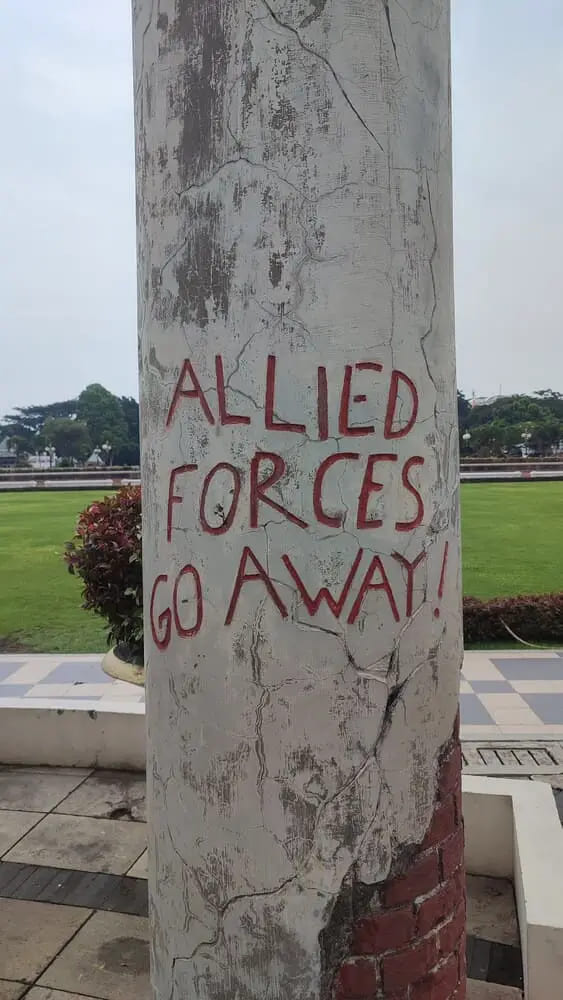

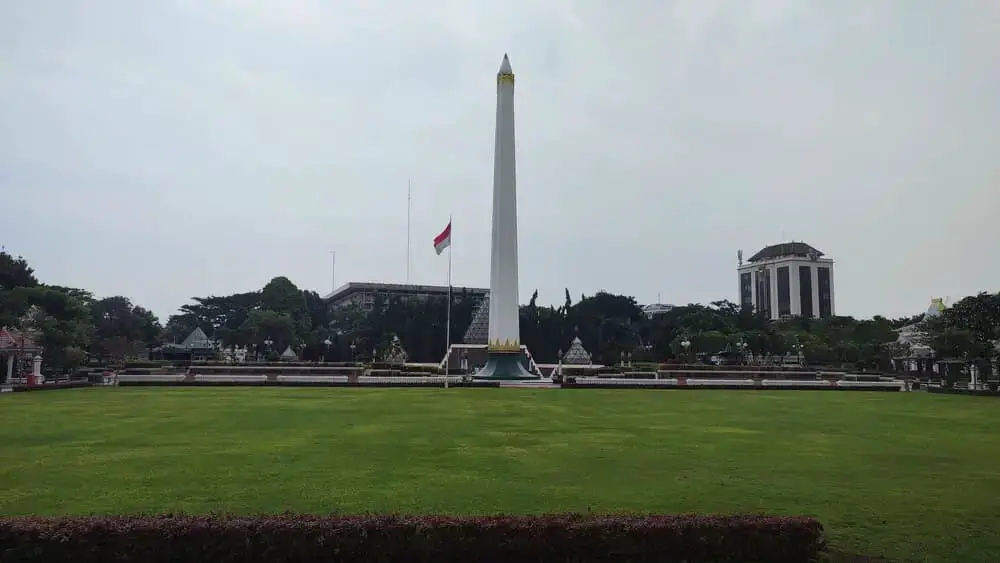
Skyscrapers, markets, and cultural hubs intermingle, showcasing a diverse culinary scene, traditional markets, and contemporary malls.
If you want to visit something really unique, go to Surabaya’s House of Sampoerna – a historic cigarette factory turned museum where you can observe workers roll a minimum of 325 cigarettes per hour!
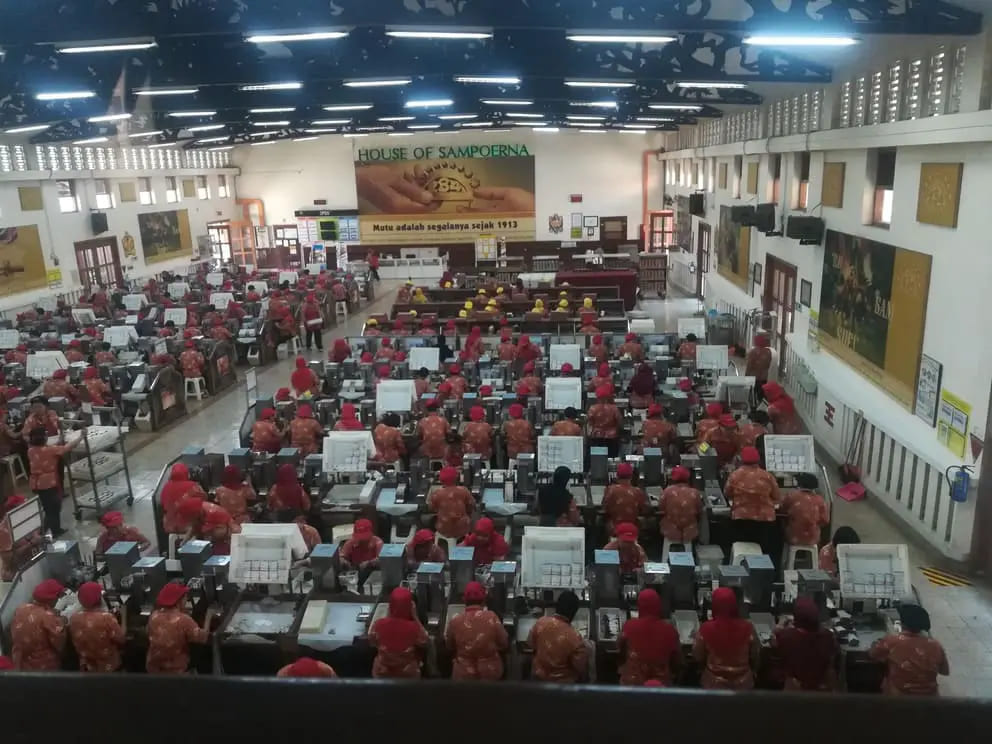
Some of the best things to do in Surabaya include:
- Heroes Monument (Tugu Pahlawan): Pay homage to Indonesia’s independence fighters at this iconic landmark.
- Ampel Mosque: A historic mosque, an important pilgrimage site, and one of the first mosques in Java. Surrounded by an Arab-themed souq market.
- Surabaya Zoo: Enjoy a day with diverse animal species and lush greenery in one of Indonesia’s oldest zoos.
- Cheng Hoo Mosque: How often do you see Chinese-style mosques? Well, this one definitely showcases Surabaya’s multicultural harmony.
- Red Bridge (Jembatan Merah): Stroll along this charming red bridge that spans the Kali Mas River, capturing picturesque views.
- Suroboyo Carnival Night Market: Experience lively night markets, complete with rides, games, and local street food.
- Submarine Monument (Monumen Kapal Selam): Tour a real submarine turned museum, offering insights into Indonesia’s naval history.
- Tunjungan Plaza: Indulge in shopping at one of Indonesia’s largest malls, offering a mix of local and international brands.
- Mirota Batik: Shop for intricate batik textiles, a traditional Indonesian art form, at this renowned store.
- Siola Building: Get a panoramic view of the city from the observation deck of this modern building.
- Alun-Alun Surabaya: Unwind in this city square surrounded by historical landmarks and bustling street food stalls.

At the end of your stay in Surabaya, either book an organized tour of Bromo or travel independently to Probolinggo.
Read the linked blog post for a self-organized budget tour of Bromo and this one for how to visit Madakaripura waterfall.
Day 13: Bromo and Madakaripura
Ladies and gentlemen, the attractions you’ve all been waiting for: Gunung Bromo and Air Terjun Madakaripura!
No Java itinerary is truly complete without these two. Actually, no trip to Indonesia is really full until you visit Mount Bromo volcano. It is the most visited place in all of Indonesia!
Bromo Volcano
Bromo is shrowded in mysticism and often literally in clouds. The Bromo Tengger Semeru National Park hosts in total of 21 active and dormant volcanoes including the highest point in Java – Mount Semeru.
Around Bromo is the otherworldly Sea of Sand. Trips most often start with a pre-dawn trek to one of the viewpoints or the Bromo crater itself to witness sunrise over the dramatic terrain (I prefer the latter to avoid the crowds at the popular viewpoints).

You can visit Bromo independently and take advantage of the secret entrance to avoid the exorbitant entrance fee.
All details, including transportation, where to sleep, how to clandestinely get in, and where to watch the sunrise over Bromo are explained in the linked article.

Madakaripura Waterfall
Madakaripura is a hidden waterfall on the way to Bromo. As most people go on organized tours that rush you to the viewpoints, and then quickly bring you back to Surabaya or Malang, a lot of visitors miss out on the wonderful Madakaripura.
The waterfall is enveloped by lush vegetation and towering cliffs presenting a majestic sight as water cascades down from a height of over 200 meters. Madakaripura is the highest waterfall in Java and the second highest in Indonesia!
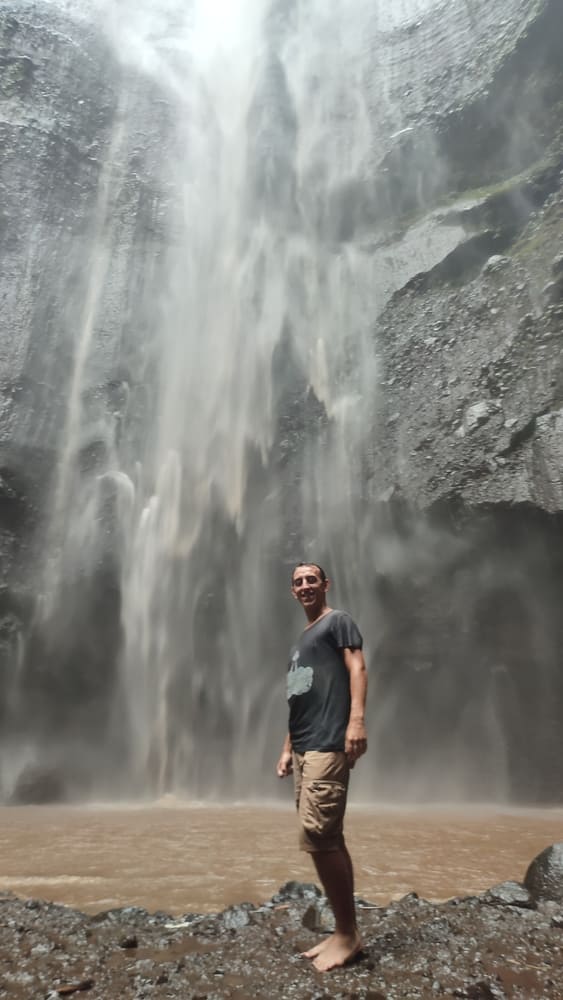
This sacred waterfall holds cultural significance, linked to the legend of Gajah Mada, an ancient Javanese warrior.
The journey to Madakaripura involves a scenic hike through verdant canyons and refreshing streams. You wade through shallow waters and pass through rocky passages to reach the waterfall’s sanctuary.
And believe me when I tell you – oh you will get wet, very, very wet!
Here’s how to visit Madakaripura and all the current information about the waterfall.
Travel from Probolinggo to Banyuwangi
These last few days of the Java backpacking Itinerary seem quite rushed. I somewhat agree. But there are just many variables, especially traveling between places, train timings, adjusting for sunrise, opening times, etc.
That’s why I advise you to be flexible with your Java itinerary and use the information here as a rough guide.
For example, you will be in Cemoro Lawang right after sunrise on Mount Bromo. You want to go back to Probolinggo and take the train towards Banyuwangi, then do a sunrise tour to Kawah Ijen. So depending on how tired you are, you might need an extra day in Banyuwangi just to recover and make the timing work.
There are daily trains from Probolinggo to Banyuwangi at 00:39, 01:57, 08:01, 16:01, and 19:17. All of them taking roughly 4 hours, with the cheapest being the Probowangi train at 08:01.
Day 14: Kawah Ijen
Your last stop on Java is on its eastern tip close to the otherwise uneventful town of Banyuwangi. There stands Kawah Ijen, a mesmerizing volcanic wonder, known for its ethereal blue flames and the world’s largest acidic lake.
This geological marvel is famous for its unique phenomenon of burning sulfuric gases, creating an otherworldly scene at night. The hike up usually starts in the dark hours before dawn and takes around 90 minutes to reach the crater.

It recently extended its opening hours and now is open from 2:00. This means it’s once again possible to see the blue fire. You can read all about Kawah Ijen here.
Sunrise at Kawah Ijen is also outstanding. It reveals breathtaking views of the acidic lake against a backdrop of rugged landscapes.
Ferry to Bali
A natural continuation of this Java backpacking itinerary is to continue onward to Bali. Make your way to the port of Ketapang (buses, taxis, and even the train connect it to Banyuwangi) and take the ferry over to Gilimanuk in Bali.

The ferries run every 30 minutes and cost 6500 IDR (0.45$).
From Gilimanuk, there are regular shuttles, tourist buses, and minibuses to Lovina or Denpasar.
Read my honest (maybe not that honest given this guide) comparison between Bali and Java.
Transport on Java
You will notice I recommend traveling by train a lot more often than by bus in this Java backpacking itinerary. Train travel on Java is easy, convenient, cheap, relatively quick, and in most sections very scenic – all characteristics that the bus journeys don’t have.
In this article about the train from Jakarta to Yogyakarta, you can find more information about Java trains.
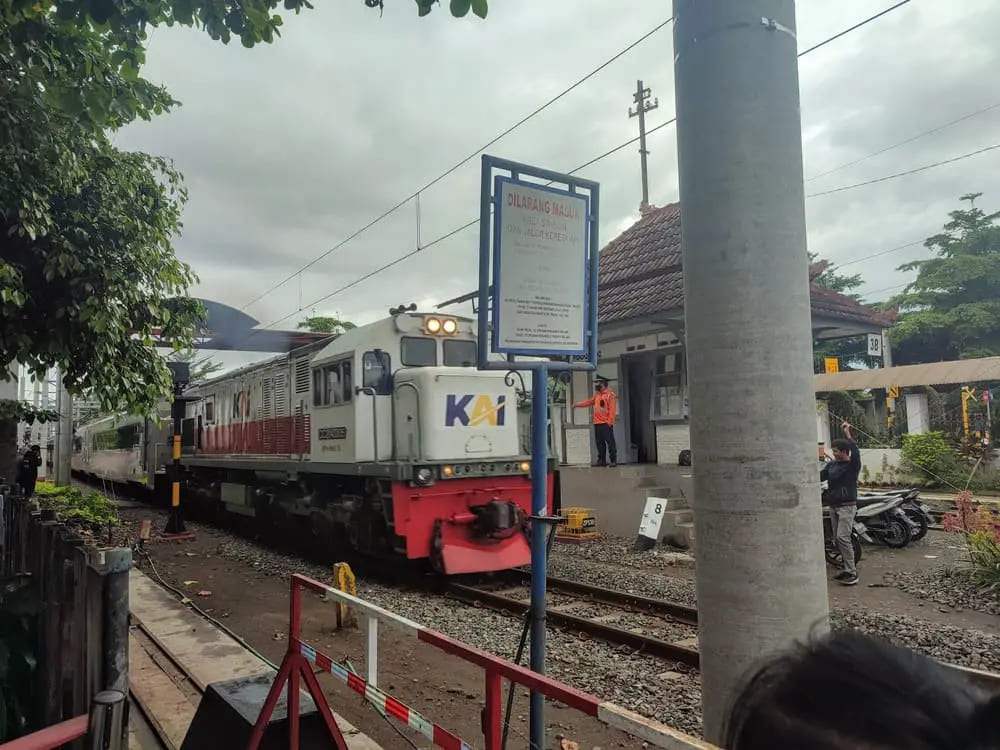
Almost all trains running on Java can be found on the KAI Access website. It is not the most user-friendly website, but it does the job. I say almost all because certain local commuter trains (for example Yogyakarta to Surakarta) aren’t listed there.
You can book and pay for the tickets online at the KAI Access website. At the train station, all you need to do is use the number or QR code from the reservation to print your ticket at the self-service kiosks. There is always staff there to help if you get confused.
Other Notable Places not Included
Java is quite big. Of course, backpacking in Java for 14 days is not enough to cover every single amazing place. Here’s a short list of the most notable I’ve not included in the itinerary. From west to east:
- Ujung Kulon National Park: The fourth UNESCO heritage site on Java that I haven’t included in this itinerary because it’s a bit off-path as it’s on the extreme western tip of the island;
- Old Banten: Discover the remnants of the historic port city of Banten, including the mighty Banten Lama Fortress and Sultan Maulana Hasanuddin’s tomb.
- Cirebon: A coastal city with a mix of Javanese and Sundanese culture, featuring the Kasepuhan Palace and Sunyaragi Cave;
- Pangandaran: a coastal paradise on Java’s southern shore. Pristine beaches, lush landscapes, vibrant sunsets, surfing opportunities, what more do you need?;
- Mount Merbabu: A dormant volcano known for its scenic trekking routes and panoramic views; Awesome sunrise. Hiking starts in the village of Selo;
- Karimunjawa Islands: A tropical paradise off the north coast of Java, offering pristine beaches, coral reefs, and diverse marine life. Reach it by ferry from Jepara (1h from Semarang);
- Mount Semeru: Java’s highest peak, an active stratovolcano exuding majestic beauty. Trekkers brave its challenging trails for breathtaking views, unique ecosystems, and the awe-inspiring Bromo-Semeru caldera;
- Savana Bekol: Part of Alas Purwo National Park (extreme east tip of Java), it features savannah landscapes and wild animals;

This Java Itinerary is FOR YOU!
There’s so much more information I can include here. Please excuse me if I didn’t entirely answer your questions about backpacking in Java.
I tried to create an evergreen resource for all backpackers coming to the wonderful country of Indonesia and its main island of Java.
If you have any other questions, feel free to reach out via the comments below, my Instagram, or Facebook. Now off you go!
